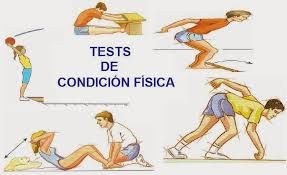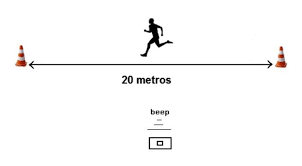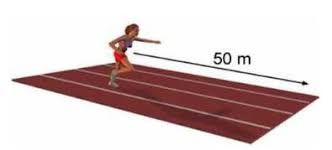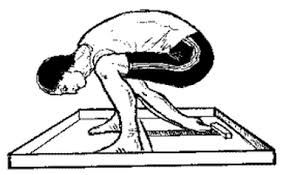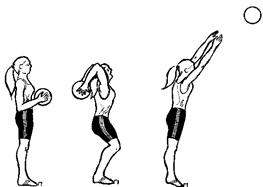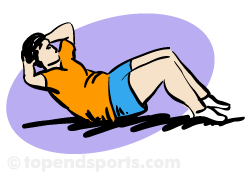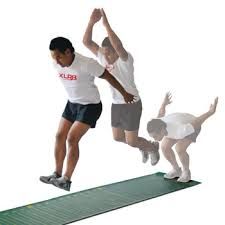Sitio web de Remigio Pérez Physical Education in Bilingual Proyects
FITNESS TEST
Stamina test
Strength test
Speed test
Flexibility test
STAMINA TEST (COURSE NAVETTE)
FITNESS TEST
Fitness test Course Navette (Stamina)
The multi-stage fitness test, also known as the PACER test or PACER (Progressive Aerobic Cardiovascular Endurance Run), the 20 m Shuttle Run Test (20 m SRT), or the beep test, is a running test used to estimate an athlete's aerobic capacity (VO2 max). In the test, athletes must run from one line to another before a timed beep. Athletes must continue running back and forth, each time reaching the line before the next beep. Once one can no longer run, the test is over and the number of laps is recorded. As the test continues, the time between beeps gets shorter. The test is used by sporting organizations around the world along with schools, militaries, and others interested in gauging one's cardiovascular endurance, an important component of overall physical fitness.
RULES: The test involves running continuously between two points that are 20 m apart from side to side (or 15 m in small gyms). The runs are synchronized with a pre-recorded audio tape, CD or computer software, which plays beeps at set intervals. As the test proceeds, the interval between each successive beep decreases, forcing the athletes to increase their speed over the course of the test until it is impossible to keep in sync with the recording (or, on extremely rare occasions, until the athlete completes the test). Many people who test people using the multi-stage fitness test allow one level to beep before the person makes the line, but some middle and grade schools allow two missed laps. If the person being tested does not make the next interval, the most recent level they completed is their final score. The recording is typically structured into 25 'levels', each lasting around 62 s. Usually, the interval of beeps is calculated as requiring a speed at the start of 8.5 km/h (see format table), increasing by 0.5 km/h with each level thereafter. The progression from one level to the next is signaled by 3 quick beeps. The highest level attained before failing to keep up is recorded as the score for that test.
SPEED TEST (50 METERS)
Maximum Speed (50m flying sprint)
The test to calculate your maximum speed is a speed test. The test uses a so-called flying start and is easy to carry out. The test consists of the following components:
Extensive warming up
Measuring times Usain Bolt’s average speed during his 100-meter world record was 37.58 km/h (including start). First do a good warming up of ten minutes during which you go through a couple of bursts of speed. This way your muscles get used to this. Start at the starting line and try to reach your starting speed in 30 meters. Try to maintain this speed for 50 meters. Register the time from 30 meters until the finish line. Important: The time you need to get up to speed does not count for the result.
Steps 1. First do a good warming up of ten minutes; 2. Start behind the line in a standard starting position; 3. Sprint forwards to the first cone. Try to reach maximum speed within the 30 meters; 4. From the cone at 30 meters, try to maintain this speed for 50 meters; 5. Register the time you take to complete the 50 meters.
FLEXIBILITY TEST (DEEP TRUNK FLEXION TEST)
The objective of this test is to measure your degree of flexibility of the body. To do this, you must squat on the indicated marks, as indicated in the figure, and pass your hands between the legs and between both feet, trying to slide them as far as possible above the ruler. It will count the mark reached with the middle finger of both hands simultaneously and symmetrically.
STRENGTH TEST ( LAUNCH MEDICINE BALL)
Test Launch Medicine Ball
The test medicine ball toss far from being a simple test launch, because the fact involve medicine ball He is very intelligent; medicine ball variable is an object weight that is much heavier than a conventional balloon, to be released this involves several muscle groups from the chest to the arms, is therefore used medicine balls great in the test medicine ball toss because with this you can test the strength of the entire upper body as the distance in which the ball is thrown.
1. Initial position. For test medicine ball toss the starting position is essential, as is a static position where the feet are separated to shoulder height, but can not be moved, because in this test can not use force caused by an impulse to throw the ball, but the force must come directly from the top ten without involving the movement of the feet. For initial position is essential not to bend your back, it is intended to make the motion and force with arms and chest, without involving the back to avoid possible injury in such a sensitive region like that; to avoid the aforementioned reasons the initial position of test medicine ball toss, the ball rests chest up straight, resting the weight of the straight body position and not holding the weight with the back extension back.
2. The movement. The move is to throw the medicine ball from the chest, over his head, trying to cover as much distance as possible; It seeks to force start the chest, and then go to the arms that extend and push the ball forward and upward; is essential not start bending back backwards movement as this may damage the lumbar area of the back, for making a movement to which said region is not structured. It is in this way that the test medicine ball toss measures the force through distance, because the farther the medicine ball comes, the greater the upper body strength of performing it.
ABS TEST
There are numerous fitness tests for measuring the function of the abdominal muscles (or 'abs' as they are generally called in the fitness industry). This is a very important area for testing, as abdominal strength or abdominal muscle endurance is an indicator of core strength and therefore core stability and support of the lower back.
The tests fall into two main categories, abdominal strength and abdominal endurance (see the list below). In the abdominal strength tests, assessed is the ability of the abdominal muscle to function optimally and hold a correct position under increasing difficulty. In the abdominal endurance tests, assessed is the ability to perform repeated abdominal curls in a set time (e.g. one minute) or at a set rate. Which test you use will be dependent of what you are trying to measure, weighed up against the costs and ease of conducting the test. The techniques for the abdominal endurance sit-up tests used for the US defense forces (US Army, US Marines, US Navy), the home test and other endurance tests vary slightly. Make note of the instructions such as where the hands are held (across the chest, behind the head, on the side of the head, out in front), how far you have to go back (shoulders to the ground, head to touch) and how far you go up (to touch your knees, chest to thighs), the angle of the knees (usually 90 degrees) and whether the feet are held or not. Being consistent with the technique will improve the reliability of the tests. When comparing the results to normative values, you should make sure that the testing technique, test conditions and subject populations are the same.
Abdominal CurlSit Up endurance tests are usually conducted over a one minute period, and measure the maximum number of correctly performed situps in that time. The home test is one example of this. The Army, Navy and Marines use a two minute test, and allow rest breaks. An alternative to the one or two minute test is a sit-up test that is continued until exhaustion at a given pace given by a metronome or audio.
Standing Long Jump Test (Broad Jump)
The Standing long jump, also called the Broad Jump, is a common and easy to administer test of explosive leg power. It is one of the fitness tests in the NFL Combine. The standing long jump was also once an event at the Olympic Games, and is also an event in Sports Hall competitions in the UK and part of the power quadrathlon and jumps decathlon assessment. purpose: to measure the explosive power of the legs equipment required: tape measure to measure distance jumped, non-slip floor for takeoff, and soft landing area preferred. Commercial Long Jump Landing Mats are also available. standing longjumpStanding Long Jump Equipment pre-test: Explain the test procedures to the subject. Perform screening of health risks and obtain informed consent. Prepare forms and record basic information such as age, height, body weight, gender and test conditions. Check and calibrate equipment if required. Perform a standard warm-up. The take off line should be clearly marked.
Procedure: The athlete stands behind a line marked on the ground with feet slightly apart. A two foot take-off and landing is used, with swinging of the arms and bending of the knees to provide forward drive. The subject attempts to jump as far as possible, landing on both feet without falling backwards. Three attempts are allowed. See some long jump video examples. scoring: The measurement is taken from take-off line to the nearest point of contact on the landing (back of the heels). Record the longest distance jumped, the best of three attempts. The table below gives a rating scale for the standing long jump test for adults, based on personal experiences. See some athlete results for the long jump test. You can also use this calculator to convert cm to feet and inches.
Comentarios recientes
05.10 | 09:57
Buenas tardes, encantado de saludarte. Soy Jose
Quería escribirte porque me ha parecido interesante comentar contigo la posibilidad de que tu negocio aparezca cada mes en periódicos digitales como not
08.09 | 09:54
Hola. ¿Cómo estás? Soy Alberto del Departamento de Prensa. Muchas gracias por atenderme.
He pensado que podría interesarte cómo podemos hacer que tu empresa aparezca en más de 50 periódicos digitales
23.07 | 05:21
Hola. ¿Cómo estás? Soy Alberto del Departamento de Prensa. Muchas gracias por atenderme.
He pensado que podría interesarte cómo podemos hacer que tu empresa aparezca en más de 50 periódicos digitales
24.04 | 16:48
Buenas tardes Alberto, te puedes poner en contacto conmigo mediante el correo electrónico, no veo ningún problema en que aparezca en prensa digital. Un saludo
Compartir esta página

